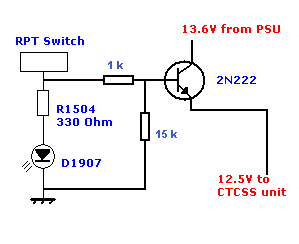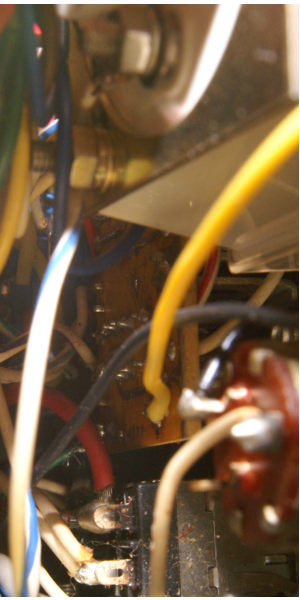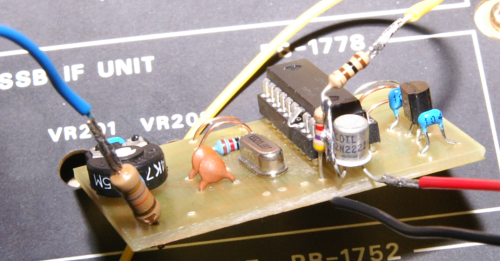Add CTCSS to your Yaesu Musen FT-225RD
Keeping old stuff operational is nice, but sometimes it is just not up-to-date enough. Like my Yaesu FT-225RD (2m) tranceiver, which is in very good
shape but it doesn't have CTCSS on board. That's why i had to use something newer to be able to work the local repeater, which only opens when you
add a 88.5 Hz subtone to your audio signal. I decided to use a CTCSS-module from Relaiszendergroep
Heerenveen, which is in Dutch, but the manual (950k) is in English.
 I want to add the subtone to only in FM mode, and only when the 600 KHz repeater-shift is turned on. Henk VK2GWK inspired me to use this RPT-switch.
The nice thing is, that there's a LED going to burn when you switch on the repeater-shift. Henk VK2GWK also made a little design how to use this switch
& LED to switch on/off the CTCSS board.
I want to add the subtone to only in FM mode, and only when the 600 KHz repeater-shift is turned on. Henk VK2GWK inspired me to use this RPT-switch.
The nice thing is, that there's a LED going to burn when you switch on the repeater-shift. Henk VK2GWK also made a little design how to use this switch
& LED to switch on/off the CTCSS board.
The thing is, that between the RPT-switch and the LED there a 330 ohm resistor and between the switch and that resistor you have 13.6V. Connect the base
of a 2N222 transistor on that 13.6V with a 1k resistor between it. You also need a resistor of 15k from base to GND. Pull 13.6V from the power supply to
the collector and you will end up with 12 Volt at the emitter of the transistor, but only when the RPT-switch is turned on (NOR or REV).
 But where's that 330 Ohm resistor????? Well, it's on the Lever Switch Board, PB-1777 which is the board where the RPT-switch is soldered on. Just behind
the front panel. Not easy to reach, but on the picture you'll find a nice spot to solder a wire on. Follow the yellow wire.
But where's that 330 Ohm resistor????? Well, it's on the Lever Switch Board, PB-1777 which is the board where the RPT-switch is soldered on. Just behind
the front panel. Not easy to reach, but on the picture you'll find a nice spot to solder a wire on. Follow the yellow wire.
Now you'll have to feed the audio subtone to the transmitter. Best way to do this, (thanks, Henk PA0HPV, not only for pointing me the right spot but
also for the whole explanation about tuning and deviation adjustment etc etc) is on the Tone Burst Unit, PB1752.
Turn your FT225 upside down, at the right side you'll find slot J21, and solder a wire on pin 9. But... you cannot sodler this wire directly to the
CTCSS-module, you'll need a 47k resistor between it! (The manual of the CTCSS-module mentioned a 100k resistor, but that's a little too much -
at least in my case).
But before soldering all that.... connect that wire from the Tone Burst Unit to a oscilloscope. Measure the amplitude while the CTCSS-module is turned
off and you are whistling in the mike. Look if it will collapse as soon as you connect it to the CTCSS-module. If so, the 47k resistor needs to be
replaced by a bigger one (100k as advised by the designers of the CTCSS-module perhaps??)
Now, turn on the CTCSS-module by activating the RPT-switch (REV or NOR). While you are still whistling, the amplitude should rise 20 to 25%. You can
adjust the voltage of the CTCSS-module by turning the 4k7 variable resistor.
After all that, you should check and adjust the deviation of your CTCSS-signal. That can be done by turning J1102 on the Tone Burst Unit. While
you're busy anyway, check the deviation of the whole FM-signal, which was originally set by the factory to 5 kHz (those were the 70's...). There's a
procedure in the manual for it, but it comes down to adjust VR502 of the Mic Amp Unit, while pin 3 should count 10.7 MHz which you can adjust with
L501. If you can't get it right, check the manual for the whole procedure.
 Here you see the CTCSS-module ready-to-rock, with the 2N222 and it's extra resistors, and the added 47K resistor for the audio signal.
Here you see the CTCSS-module ready-to-rock, with the 2N222 and it's extra resistors, and the added 47K resistor for the audio signal.
I didn't use the mute-option of the CTCSS-module, i just turn it on and off with the RPT-switch. Consequence is, that it will keep generating the
subtone all the time, even while receiving, but i found that this is not a problem. You're mike is doing the same, even with a released PTT-switch.
I cannot be held responsible for any damage caused by this Howto.
Enjoy! Jeroen PA3JT
 I want to add the subtone to only in FM mode, and only when the 600 KHz repeater-shift is turned on. Henk VK2GWK inspired me to use this RPT-switch.
The nice thing is, that there's a LED going to burn when you switch on the repeater-shift. Henk VK2GWK also made a little design how to use this switch
& LED to switch on/off the CTCSS board.
I want to add the subtone to only in FM mode, and only when the 600 KHz repeater-shift is turned on. Henk VK2GWK inspired me to use this RPT-switch.
The nice thing is, that there's a LED going to burn when you switch on the repeater-shift. Henk VK2GWK also made a little design how to use this switch
& LED to switch on/off the CTCSS board.  But where's that 330 Ohm resistor????? Well, it's on the Lever Switch Board, PB-1777 which is the board where the RPT-switch is soldered on. Just behind
the front panel. Not easy to reach, but on the picture you'll find a nice spot to solder a wire on. Follow the yellow wire.
But where's that 330 Ohm resistor????? Well, it's on the Lever Switch Board, PB-1777 which is the board where the RPT-switch is soldered on. Just behind
the front panel. Not easy to reach, but on the picture you'll find a nice spot to solder a wire on. Follow the yellow wire.
 Here you see the CTCSS-module ready-to-rock, with the 2N222 and it's extra resistors, and the added 47K resistor for the audio signal.
Here you see the CTCSS-module ready-to-rock, with the 2N222 and it's extra resistors, and the added 47K resistor for the audio signal.